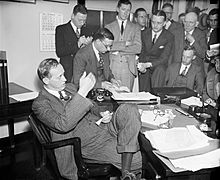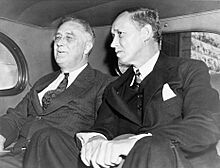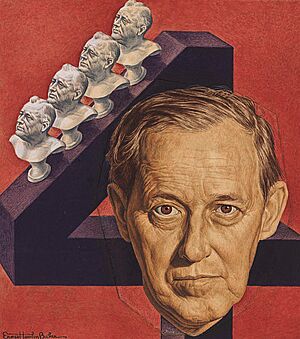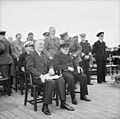Harry Hopkins facts for kids
Quick facts for kids
Harry Hopkins
|
|
|---|---|
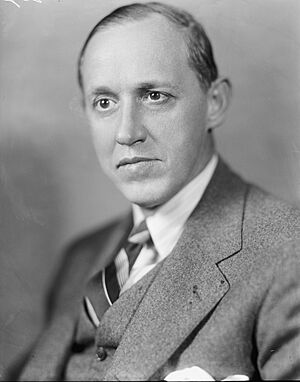 |
|
| 8th United States Secretary of Commerce | |
| In office December 24, 1938 – September 18, 1940 |
|
| President | Franklin D. Roosevelt |
| Preceded by | Daniel C. Roper |
| Succeeded by | Jesse H. Jones |
| Administrator of the Works Progress Administration | |
| In office May 6, 1935 – December 24, 1938 |
|
| President | Franklin D. Roosevelt |
| Preceded by | Position established |
| Succeeded by | Francis C. Harrington |
| Administrator of the Federal Emergency Relief Administration | |
| In office May 12, 1933 – May 6, 1935 |
|
| President | Franklin D. Roosevelt |
| Preceded by | Position established |
| Succeeded by | Position abolished |
| Administrator of the Civil Works Administration | |
| In office November 8, 1933 – March 31, 1934 |
|
| President | Franklin D. Roosevelt |
| Preceded by | Position established |
| Succeeded by | Position abolished |
| Personal details | |
| Born |
Harold Lloyd Hopkins
August 17, 1890 Sioux City, Iowa U.S. |
| Died | January 29, 1946 (aged 55) New York City, New York, U.S. |
| Political party | Democratic |
| Spouses |
Ethel Gross
(m. 1913; div. 1929)Barbara Duncan
(m. 1931; died 1937)Louise Gill Macy
(m. 1942) |
| Children | 5 |
| Education | Grinnell College (BA) |
Harold Lloyd "Harry" Hopkins (August 17, 1890 – January 29, 1946) was an important American helper and advisor to President Franklin D. Roosevelt. He played a big role in the New Deal programs, which aimed to help the country during the Great Depression. Later, he became the eighth United States Secretary of Commerce from 1938 to 1940.
During World War II, Hopkins was Roosevelt's main advisor on foreign policy. He worked closely with leaders of the Allied countries. He helped manage huge programs like Lend-Lease, which sent military aid to the Allies. Hopkins was also key in building a strong friendship between the United States and the United Kingdom.
Born in Iowa, Hopkins moved to New York City after college. He worked for groups that helped children and public health. His success in managing relief programs in New York caught the eye of then-Governor Roosevelt. When Roosevelt became president in 1932, he brought Hopkins to Washington. Hopkins had a very close relationship with both President Roosevelt and First Lady Eleanor Roosevelt.
Contents
Early Life and Helping Others
Harry Hopkins was born in Sioux City, Iowa, in 1890. He was one of five children. His family moved several times before settling in Grinnell, Iowa.
After graduating from Grinnell College in 1912, Hopkins moved to New York City. He started working at Christodora House, a place that helped people in need in the city. He also worked for the New York Association for Improving the Condition of the Poor. Here, he helped organize one of the first public employment programs in the United States. This program gave jobs to people during a tough economic time in 1915.
In 1915, the Mayor of New York City made Hopkins the executive secretary of the Bureau of Child Welfare. This group helped mothers who had children to support.
Social Work and Public Health
Hopkins worked for the American Red Cross in New Orleans during World War I. He helped civilians during the war. He later became the general manager for the Red Cross in the South. In 1923, he was chosen as president of the American Association of Social Workers.
He returned to New York City in 1922 and worked on health projects. He became the executive director of the New York Tuberculosis Association. Under his leadership, this organization grew a lot and even took in the New York Heart Association.
In 1931, New York Governor Franklin D. Roosevelt appointed Jesse Straus to lead the Temporary Emergency Relief Administration (TERA). Straus then hired Hopkins as the executive director. Hopkins managed the agency very well, which impressed Roosevelt. In 1932, Roosevelt promoted Hopkins to lead TERA. Hopkins also became good friends with Eleanor Roosevelt, which helped him in his work with relief programs.
The New Deal Programs
In 1933, President Roosevelt asked Hopkins to come to Washington, D.C. to lead federal relief efforts. Hopkins believed that giving people jobs was better for them than just giving out money. He wanted to continue and expand the work relief programs he started in New York.
He oversaw several major New Deal programs:
- The Federal Emergency Relief Administration (FERA)
- The Civil Works Administration (CWA)
- The Works Progress Administration (WPA)
More than 90% of the people hired by Hopkins's programs were unemployed or needed help. He worked to create jobs for millions of Americans during the Great Depression.
Building America with the WPA
The CWA, for example, hired four million people in less than four months. In just five months, the CWA built or fixed:
- 200 swimming pools
- 3,700 playgrounds
- 40,000 schools
- 250,000 miles (400,000 km) of road
- 12 million feet (3.7 million meters) of sewer pipe
The WPA was even bigger. Over seven years, it employed 8.5 million people. They worked on 1.4 million projects, including building or repairing:
- 103 golf courses
- 1,000 airports
- 2,500 hospitals
- 2,500 sports stadiums
- 3,900 schools
- 8,192 parks
- 12,800 playgrounds
- 124,031 bridges
- 125,110 public buildings
- 651,087 miles (1,047,823 km) of highways and roads
Hopkins also started programs for young people, called the National Youth Administration. He also created programs for artists and writers, known as the Federal One Programs. Hopkins and Eleanor Roosevelt worked together to tell people about and defend these New Deal programs.
World War II Efforts

In May 1940, as World War II began to spread in Europe, President Roosevelt asked Hopkins to live in the White House. Hopkins stayed there for over three years, helping the president manage American foreign policy. He focused especially on relations with the United Kingdom and the Soviet Union.
On December 7, 1941, Hopkins was having lunch with President Roosevelt when they received the news that Pearl Harbor had been attacked.
During the war, Hopkins became Roosevelt's main helper for British Prime Minister Winston Churchill. In January 1941, Roosevelt sent Hopkins to Britain to see how determined they were to fight. Churchill showed Hopkins around the country. Hopkins told Churchill that he would tell Roosevelt: "Whither thou goest, I will go and where thou lodgest I will lodge, thy people shall be my people, and thy God my God." This showed how committed the U.S. was to helping Britain.
Hopkins then became the administrator of the Lend-Lease program. This program allowed the United States to give food, oil, military ships, planes, and weapons to Britain, the Soviet Union, China, and other Allied nations. The Allies would repay the U.S. mainly by fighting the enemy and allowing American forces to use their military bases.
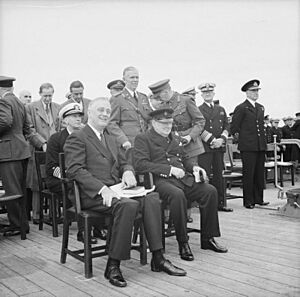
Hopkins had a big say in how the $50 billion Lend-Lease program was run. He made sure supplies went first to Britain, and then to the Soviets after Germany invaded them. He even went to Moscow in July 1941 to meet Joseph Stalin in person. Hopkins suggested, and Roosevelt agreed, to include the Soviets in Lend-Lease. He made these decisions based on Roosevelt's overall foreign policy goals.
Hopkins traveled with Roosevelt to important meetings with Churchill and Stalin. These included the Cairo, Tehran, Casablanca in 1942–43, and Yalta in 1945. He was a strong supporter of China, which also received Lend-Lease aid. Hopkins had a lot of diplomatic power, even more than the official State Department. He also helped find and support future leaders, like Dwight D. Eisenhower.
Relations with the Soviet Union
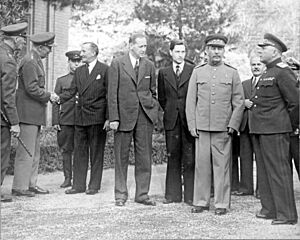
Harry Hopkins was the main American official who worked with Soviet leaders during World War II. He talked with Soviet officials from different levels, including Joseph Stalin. He often explained Roosevelt's plans to Stalin to get Soviet support for American goals.
As the top American decision-maker for Lend-Lease, Hopkins made sure the Soviet Union received supplies. He believed that since Soviet soldiers were doing a lot of the fighting, American help would end the war faster.
In August 1943, Hopkins spoke about the Soviet Union's important role in the war. He said that "Without Russia in the war, the Axis cannot be defeated in Europe." He also noted that "Russia's post-war position in Europe will be a dominant one."
Some people later claimed that Hopkins passed secrets to the Soviets. However, historians have found no proof that he shared any unauthorized secrets or made decisions that went against American interests to help communism. Any actions he took were meant to help the American war effort and prevent the Soviets from making a deal with Hitler.
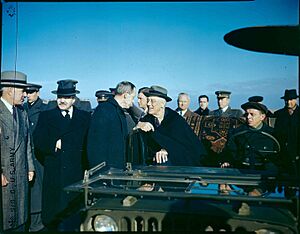
Hopkins had three sons who served in the military during the war. Sadly, his son Stephen was killed in action while serving in the Marine Corps.
Personal Life and Health
In 1913, Hopkins married Ethel Gross. They had three sons: David, Robert, and Stephen. They divorced in 1930, but remained in touch. In 1931, he married Barbara Duncan, who passed away six years later. They had one daughter, Diana. In 1942, Hopkins married Louise Gill Macy in the Yellow Oval Room at the White House.
In 1939, Hopkins was diagnosed with stomach cancer. Doctors removed most of his stomach. He was very ill, but his important role in the war effort seemed to give him strength. As one historian wrote, his work "postponed the sentence of death the doctors had given him for five more years."
Harry Hopkins died in New York City on January 29, 1946, at the age of 55. His ashes were buried in Grinnell, Iowa, where he went to college. There is a house on the Grinnell College campus named after him.
Images for kids


